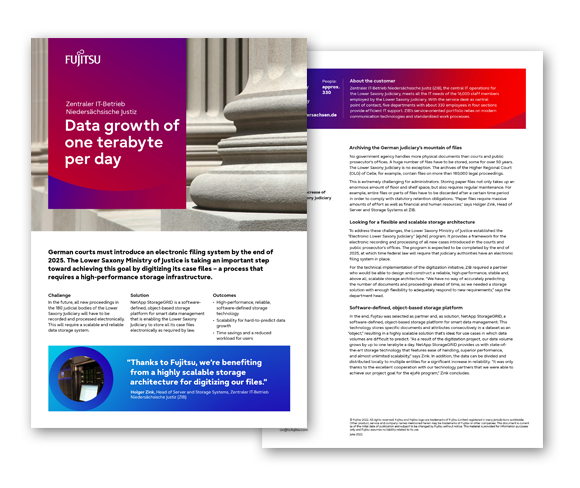Zentraler IT-Betrieb Niedersächsische Justiz
Data growth of one terabyte per day
German courts must introduce an electronic filing system by the end of 2025. The Lower Saxony Ministry of Justice is taking an important step toward achieving this goal by digitizing its case files – a process that requires a high-performance storage infrastructure.
Challenge
In the future, all new proceedings in the 180 judicial bodies of the Lower Saxony Judiciary will have to be recorded and processed electronically. This will require a scalable and reliable data storage system.
Solution
NetApp StorageGRID is a software-defined, object-based storage platform for smart data management that is enabling the Lower Saxony Judiciary to store all its case files electronically as required by law.
Outcomes
- High-performance, reliable, software-defined storage technology
- Scalability for hard-to predict data growth
- Time savings and a reduced workload for users
Thanks to Fujitsu, we’re benefiting from a highly scalable storage architecture for digitizing our files.
Holger Zink, Head of Server and Storage Systems, Zentraler IT-Betrieb Niedersächsische Justiz (ZIB)

1 TB
data volume increase of the Lower Saxony Judiciary per day
- Industry: Judiciary
- Location: Germany
- People: approx. 330
- Customer's website
About the customer
Zentraler IT-Betrieb Niedersächsische Justiz (ZIB), the central IT operations for the Lower Saxony Judiciary, meets all the IT needs of the 16,000 staff members employed by the Lower Saxony Judiciary. With the service desk as central point of contact, five departments with about 330 employees in four sections provide efficient IT support. ZIB’s service-oriented portfolio relies on modern communication technologies and standardized work processes.
Archiving the German judiciary’s mountain of files
No government agency handles more physical documents than courts and public prosecutor’s offices. A huge number of files have to be stored, some for over 50 years. The Lower Saxony Judiciary is no exception. The archives of the Higher Regional Court (OLG) of Celle, for example, contain files on more than 180,000 legal proceedings.
This is extremely challenging for administrators. Storing paper files not only takes up an enormous amount of floor and shelf space, but also requires regular maintenance. For example, entire files or parts of files have to be discarded after a certain time period in order to comply with statutory retention obligations. “Paper files require massive amounts of effort as well as financial and human resources,” says Holger Zink, Head of Server and Storage Systems at ZIB.
Looking for a flexible and scalable storage architecture
To address these challenges, the Lower Saxony Ministry of Justice established the “Electronic Lower Saxony Judiciary” (eJuNi) program. It provides a framework for the electronic recording and processing of all new cases introduced in the courts and public prosecutor’s offices. The program is expected to be completed by the end of 2025, at which time federal law will require that judiciary authorities have an electronic filing system in place.
For the technical implementation of the digitization initiative, ZIB required a partner who would be able to design and construct a reliable, high-performance, stable and, above all, scalable storage architecture. “We have no way of accurately predicting the number of documents and proceedings ahead of time, so we needed a storage solution with enough flexibility to adequately respond to new requirements,” says the department head.
Software-defined, object-based storage platform
In the end, Fujitsu was selected as partner and, as solution, NetApp StorageGRID, a software-defined, object-based storage platform for smart data management. This technology stores specific documents and attributes consecutively in a dataset as an “object,” resulting in a highly scalable solution that’s ideal for use cases in which data volumes are difficult to predict. “As a result of the digitization project, our data volume grows by up to one terabyte a day. NetApp StorageGRID provides us with state-of-the-art storage technology that features ease of handling, superior performance, and almost unlimited scalability,” says Zink. In addition, the data can be divided and distributed locally to multiple entities for a significant increase in reliability. “It was only thanks to the excellent cooperation with our technology partners that we were able to achieve our project goal for the eJuNi program,” Zink concludes.








